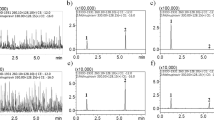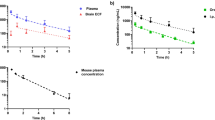Abstract
Purpose. This study examines the central nervous system (CNS) delivery of 2′-β-fluoro-2′,3′-dideoxyadenosine (F-ddA) and 2′-β-fluoro-2′,3′-dideoxyinosine (F-ddl), acid stable analogues of dideoxyadenosine (ddA) and dideoxyinosine (ddI) having reduced susceptibility to purine salvage pathway enzymes important in the metabolism of ddA and ddI, adenosine deaminase (ADA) and purine nucleoside phosphorylase (PNP), respectively. Their CNS delivery compared to that for ddI provides insight into the role of brain tissue ADA and PNP in these processes.
Methods. Brain and cerebrospinal fluid (CSF) concentration-time profiles were obtained for F-ddI during and after intravenous infusions of F-ddl, and for both F-ddA and F-ddI after F-ddA infusions in normal rats or rats pre-treated with the ADA inhibitor 2′-deoxycoformycin (DCF). Rate constants for CNS entry, efflux and metabolism were estimated by computer fits using plasma concentration-time profiles as the driving force functions.
Results. The CNS delivery of F-ddI did not differ significantly from that for ddI. F-ddA, which is more lipophilic than F-ddI, provided higher brain (≈ 8×) and CSF (≈ 11×) concentrations of total dideoxynucleoside (F-ddA and F-ddI) compared to F-ddI. Deamination by brain tissue ADA to form F-ddI reduced CNS levels of intact F-ddA but provided higher brain parenchyma (5×) and CSF/plasma (3×) ratios of F-ddI relative to F-ddI controls. Thus, F-ddA functions in part as a CNS-activated prodrug of F-ddI. DCF pre-treatment inhibited brain tissue ADA, abolishing the prodrug effect, and enhancing F-ddA concentrations in both brain parenchyma (5×) and CSF (6×).
Conclusions. PNP metabolism does not appear to play a role in the low CNS delivery of ddI. On the other hand, deamination of F-ddA by brain tissue ADA is an important process, such that F-ddA functions in part as a CNS-activated prodrug of F-ddI. Enhanced CNS uptake of intact F-ddA can be achieved with ADA inhibition.
Similar content being viewed by others
REFERENCES
R. W. Price and B. J. Brew J. Infect. Dis. 158:1079–1083 (1988).
R. W. Price. Res. Publ. Assoc. Res. Nerv. Ment. Dis. 72:1–45 (1994).
K. M. Butler, R. N. Husson, F. M. Balis, P. Brouwers, J. Eddy, D. El-Amin, J. Gress, M. Hawkins, P. Jarosinski, H. Moss, D. Poplack, S. Santacroce, D. Venzon, L. Wiener, P. Wolters, and P. A. Pizzo. New Engl. J. Med. 324:137–144 (1991).
P. A. Pizzo, K. Butler, F. Balis, E. Brouwers, M. Hawkins, J. Eddy, M. Einloth, J. Falloon, R. Hussan, P. Jarosinski, J. Meer, H. Moss, D. G. Poplack, S. Santacrose, L. Wiener, and P. Wolters. J. Pediatr. 117:799–808 (1990).
P. A. Pizzo, J. Eddy, J. Falloon, F. M. Balis, R. F. Murphy, H. Moss, P. Wolters, P. Brouwers, P. Jarosinski, M. Rubin, S. Broder, R. Yarchoan, A. Brunett, M. Maha, S. Nusinhoff-Lehrman, and D. G. Poplack. N. Engl. J. Med. 319:889–896 (1988).
E. Sandstrom and B. Oberg. Drugs 45:488–508 (1993).
B. D. Anderson, B. L. Hoesterey, D. C. Baker, and R. E. Galinsky. J Pharmacol. Exp. Ther. 253:113–118 (1990).
D. J. Back, S. Ormesher, J. F. Tjia, and R. Macleod. Br. J. Clin. Pharmacol. 33:319–322 (1992).
R. E. Parks, Jr., G. W. Crabtree, C. M. Kong, R. P. Agarwal, K. C. Agarwal, and E. M. Scholar. Ann. N.Y. Acad. Sci. 255:412–434 (1975).
G. Mistry and G. I. Drummond. J. Mol. Cell Cardiol. 18:13–22 (1986).
M. D. Johnson and B. D. Anderson. Pharm. Res. 13:1881–1886 (1996).
V. E. Marquez, C. K.-H. Tseng, J. A. Kelley, H. Mitsuya, S. Broder, J. S. Roth, and J. S. Driscoll. Biochem. Pharmacol. 36:2719–2722 (1987).
V. E. Marquez, C. K.-H. Tseng, H. Mitsuya, S. Aoki, J. A. Kelley, J. Ford, H., J. S. Roth, S. Broder, D. G. Johns, and J. S. Driscoll. J. Med. Chem. 33:978–985 (1990).
G. S. Ahluwalia, D. A. Cooney, T. Shirasaka, H. Mitsuya, J. S. Driscoll, and D. G. Johns. Mol. Pharmacol. 46:1002–1008 (1994).
C. L. Zielke and C. H. Suelter. In P. D. Boyer, (ed.) The Enzymes, Academic, London, 1971, vol. 4, pp. 47–78.
T. G. Brady and C. I. O'Donovan. Comp. Biochem. Physiol. 14:101–120 (1965).
R. Masood, G. S. Ahluwalia, D. A. Cooney, A. Fridland, V. E. Marquez, J. S. Driscoll, Z. Hao, H. Mitsuya, C. F. Perno, S. Broder, and D. G. Johns. Mol. Pharmacol. 37:590–6 (1990).
J. J. Barchi, Jr., V. E. Marquez, J. S. Driscoll, H. Ford, Jr., H. Mitsuya, T. Shirasaka, S. Aoki, and J. A. Kelley. J. Med. Chem. 34:1647–1655 (1991).
D. Singhal, M. E. Morgan, and B. D. Anderson. Drug Metab. Disp. 24:1155–1161 (1996).
H. B. Waynforth. Experimental and Surgical Techniques in the Rat, Academic Press, London, 1980.
R. E. Galinsky, K. K. Flaharty, B. L. Hoesterey, and B. D. Anderson. J. Pharmacol. Exp. Ther. 257:972–978 (1991).
B. D. Anderson, R. E. Galinsky, D. C. Baker, S.-C. Chi, B. L. Hoesterey, M. E. Morgan, K. Murakami, and H. Mitsuya. J. Control. Rel. 19:219–230 (1992).
M. E. Brewster, W. R. Anderson, D. O. Helton, N. Bodor, and E. Pop. Pharm. Res. 12:796–798 (1995).
M. E. Brewster, W. Anderson, and N. Bodor. J. Pharm. Sci. 80:843–846 (1991).
M. E. Morgan, S.-C. Chi, K. Murakami, H. Mitsuya, and B. D. Anderson. Antimicrob. Agents Chemother. 36:2156–2165 (1992).
N. Clumeck. J. Antimicrob. Chemother. 32:133–138 (1993).
H. Mitsuya, R. Yarchoan, and S. Broder. Sci. 249:1533–1544 (1990).
H. Mitsuya and S. Broder. In R. C. Gallo, G. Jay, (ed.) The Human retoviruses, Academic Press, Inc., San Diego, 1991, 335–378.
D. A. Cooney, G. Ahluwalia, H. Mitsuya, A. Fridland, M. Johnson, Z. Hao, M. Dalal, J. Balzarini, S. Broder, and D. G. Johns. Biochem. Pharmacol. 36:1765–1768 (1987).
Author information
Authors and Affiliations
Rights and permissions
About this article
Cite this article
Singhal, D., Morgan, M.E. & Anderson, B.D. Role of Brain Tissue Localized Purine Metabolizing Enzymes in the Central Nervous System Delivery of Anti-HIV Agents 2′-β-Fluoro-2,3′-Dideoxyinosine and 2′-β-Fluoro-2′,3′-Dideoxyadenosine in Rats. Pharm Res 14, 786–792 (1997). https://doi.org/10.1023/A:1012110724604
Issue Date:
DOI: https://doi.org/10.1023/A:1012110724604




